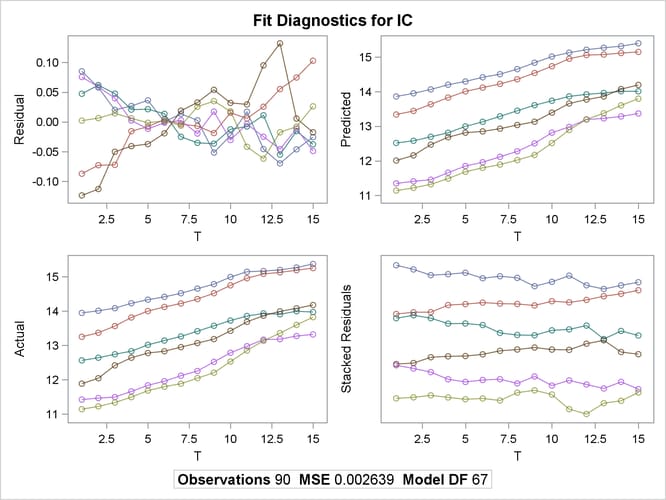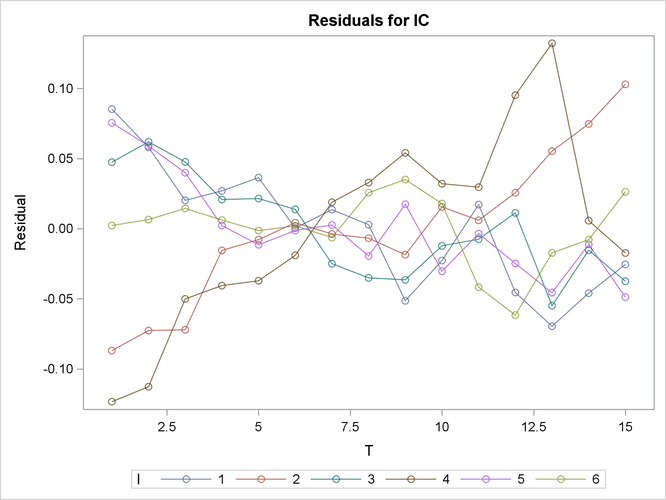The PANEL Procedure
- Overview
- Getting Started
-
Syntax

-
Details
 Specifying the Input DataSpecifying the Regression ModelUnbalanced DataMissing ValuesComputational ResourcesRestricted EstimatesNotationOne-Way Fixed-Effects ModelTwo-Way Fixed-Effects ModelBalanced PanelsUnbalanced PanelsFirst-Differenced Methods for One-Way and Two-Way ModelsBetween EstimatorsPooled EstimatorOne-Way Random-Effects ModelTwo-Way Random-Effects ModelHausman-Taylor EstimationAmemiya-MaCurdy EstimationParks Method (Autoregressive Model)Da Silva Method (Variance-Component Moving Average Model)Dynamic Panel EstimatorsLinear Hypothesis TestingHeteroscedasticity-Corrected Covariance MatricesHeteroscedasticity- and Autocorrelation-Consistent Covariance MatricesR-SquareSpecification TestsPanel Data Poolability TestPanel Data Cross-Sectional Dependence TestPanel Data Unit Root TestsLagrange Multiplier (LM) Tests for Cross-Sectional and Time EffectsTests for Serial Correlation and Cross-Sectional EffectsTroubleshootingCreating ODS GraphicsOUTPUT OUT= Data SetOUTEST= Data SetOUTTRANS= Data SetPrinted OutputODS Table Names
Specifying the Input DataSpecifying the Regression ModelUnbalanced DataMissing ValuesComputational ResourcesRestricted EstimatesNotationOne-Way Fixed-Effects ModelTwo-Way Fixed-Effects ModelBalanced PanelsUnbalanced PanelsFirst-Differenced Methods for One-Way and Two-Way ModelsBetween EstimatorsPooled EstimatorOne-Way Random-Effects ModelTwo-Way Random-Effects ModelHausman-Taylor EstimationAmemiya-MaCurdy EstimationParks Method (Autoregressive Model)Da Silva Method (Variance-Component Moving Average Model)Dynamic Panel EstimatorsLinear Hypothesis TestingHeteroscedasticity-Corrected Covariance MatricesHeteroscedasticity- and Autocorrelation-Consistent Covariance MatricesR-SquareSpecification TestsPanel Data Poolability TestPanel Data Cross-Sectional Dependence TestPanel Data Unit Root TestsLagrange Multiplier (LM) Tests for Cross-Sectional and Time EffectsTests for Serial Correlation and Cross-Sectional EffectsTroubleshootingCreating ODS GraphicsOUTPUT OUT= Data SetOUTEST= Data SetOUTTRANS= Data SetPrinted OutputODS Table Names -
Examples

- References
Example 27.2 The Airline Cost Data: Fixtwo Model
The Christenson Associates airline data are a frequently cited data set (see Greene 2000). The data measure costs, prices of inputs, and utilization rates for six airlines over the time span 1970–1984. This example analyzes the log transformations of the cost, price and quantity, and the raw (not logged) capacity utilization measure. You speculate the following model:

where the  are the pure cross-sectional effects and
are the pure cross-sectional effects and  are the time effects. The actual model speculated is highly nonlinear in the original variables. It would look like the following:
are the time effects. The actual model speculated is highly nonlinear in the original variables. It would look like the following:

The data and preliminary SAS statements are:
data airline; input Obs I T C Q PF LF; label obs = "Observation number"; label I = "Firm Number (CSID)"; label T = "Time period (TSID)"; label Q = "Output in revenue passenger miles (index)"; label C = "Total cost, in thousands"; label PF = "Fuel price"; label LF = "Load Factor (utilization index)"; datalines; ... more lines ...
data airline; set airline; lC = log(C); lQ = log(Q); lPF = log(PF); label lC = "Log Transformation of Costs"; label lQ = "Log Transformation of Quantity"; label lPF= "Log Transformation of Price of Fuel"; run;
The following statements fit the model:
proc panel data=airline printfixed; id i t; model lC = lQ lPF LF / fixtwo; run;
First, you see the model’s description in Output 27.2.1. The model is a two-way fixed-effects model. There are six cross sections and fifteen time observations.
Output 27.2.1: The Airline Cost Data—Model Description
The R-square and degrees of freedom can be seen in Output 27.2.2. On the whole, you see a large R-square, so there is a reasonable fit. The degrees of freedom of the estimate are 90 minus 14 time dummy variables minus 5 cross section dummy variables and 4 regressors.
Output 27.2.2: The Airline Cost Data—Fit Statistics
The F test for fixed effects is shown in Output 27.2.3. Testing the hypothesis that there are no fixed effects, you easily reject the null of poolability. There are group effects, or time effects, or both. The test is highly significant. OLS would not give reasonable results.
Output 27.2.3: The Airline Cost Data—Test for Fixed Effects
Looking at the parameters, you see a more complicated pattern. Most of the cross-sectional effects are highly significant
(with the exception of CS2). This means that the cross sections are significantly different from the sixth cross section.
Many of the time effects show significance, but this is not uniform. It looks like the significance might be driven by a large
 period effect, since the first six time effects are negative and of similar magnitude. The time dummy variables taper off
in size and lose significance from time period 12 onward. There are many causes to which you could attribute this decay of
time effects. The time period of the data spans the OPEC oil embargoes and the dissolution of the Civil Aeronautics Board
(CAB). These two forces are two possible reasons to observe the decay and parameter instability. As for the regression parameters,
you see that quantity affects cost positively, and the price of fuel has a positive effect, but load factors negatively affect
the costs of the airlines in this sample. The somewhat disturbing result is that the fuel cost is not significant. If the
time effects are proxies for the effect of the oil embargoes, then an insignificant fuel cost parameter would make some sense.
If the dummy variables proxy for the dissolution of the CAB, then the effect of load factors is also not being precisely estimated.
period effect, since the first six time effects are negative and of similar magnitude. The time dummy variables taper off
in size and lose significance from time period 12 onward. There are many causes to which you could attribute this decay of
time effects. The time period of the data spans the OPEC oil embargoes and the dissolution of the Civil Aeronautics Board
(CAB). These two forces are two possible reasons to observe the decay and parameter instability. As for the regression parameters,
you see that quantity affects cost positively, and the price of fuel has a positive effect, but load factors negatively affect
the costs of the airlines in this sample. The somewhat disturbing result is that the fuel cost is not significant. If the
time effects are proxies for the effect of the oil embargoes, then an insignificant fuel cost parameter would make some sense.
If the dummy variables proxy for the dissolution of the CAB, then the effect of load factors is also not being precisely estimated.
Output 27.2.4: The Airline Cost Data—Parameter Estimates
| Parameter Estimates | ||||||
|---|---|---|---|---|---|---|
| Variable | DF | Estimate | Standard Error |
t Value | Pr > |t| | Label |
| CS1 | 1 | 0.174237 | 0.0861 | 2.02 | 0.0470 | Cross Sectional Effect 1 |
| CS2 | 1 | 0.111412 | 0.0780 | 1.43 | 0.1576 | Cross Sectional Effect 2 |
| CS3 | 1 | -0.14354 | 0.0519 | -2.77 | 0.0073 | Cross Sectional Effect 3 |
| CS4 | 1 | 0.18019 | 0.0321 | 5.61 | <.0001 | Cross Sectional Effect 4 |
| CS5 | 1 | -0.04671 | 0.0225 | -2.08 | 0.0415 | Cross Sectional Effect 5 |
| TS1 | 1 | -0.69286 | 0.3378 | -2.05 | 0.0442 | Time Series Effect 1 |
| TS2 | 1 | -0.63816 | 0.3321 | -1.92 | 0.0589 | Time Series Effect 2 |
| TS3 | 1 | -0.59554 | 0.3294 | -1.81 | 0.0751 | Time Series Effect 3 |
| TS4 | 1 | -0.54192 | 0.3189 | -1.70 | 0.0939 | Time Series Effect 4 |
| TS5 | 1 | -0.47288 | 0.2319 | -2.04 | 0.0454 | Time Series Effect 5 |
| TS6 | 1 | -0.42705 | 0.1884 | -2.27 | 0.0267 | Time Series Effect 6 |
| TS7 | 1 | -0.39586 | 0.1733 | -2.28 | 0.0255 | Time Series Effect 7 |
| TS8 | 1 | -0.33972 | 0.1501 | -2.26 | 0.0269 | Time Series Effect 8 |
| TS9 | 1 | -0.2718 | 0.1348 | -2.02 | 0.0478 | Time Series Effect 9 |
| TS10 | 1 | -0.22734 | 0.0763 | -2.98 | 0.0040 | Time Series Effect 10 |
| TS11 | 1 | -0.1118 | 0.0319 | -3.50 | 0.0008 | Time Series Effect 11 |
| TS12 | 1 | -0.03366 | 0.0429 | -0.78 | 0.4354 | Time Series Effect 12 |
| TS13 | 1 | -0.01775 | 0.0363 | -0.49 | 0.6261 | Time Series Effect 13 |
| TS14 | 1 | -0.01865 | 0.0305 | -0.61 | 0.5430 | Time Series Effect 14 |
| Intercept | 1 | 12.93834 | 2.2181 | 5.83 | <.0001 | Intercept |
| lQ | 1 | 0.817264 | 0.0318 | 25.66 | <.0001 | Log Transformation of Quantity |
| lPF | 1 | 0.168732 | 0.1635 | 1.03 | 0.3057 | Log Transformation of Price of Fuel |
| LF | 1 | -0.88267 | 0.2617 | -3.37 | 0.0012 | Load Factor (utilization index) |
ODS Graphics Plots
ODS graphics plots can be obtained to graphically analyze the results. The following statements show how to generate the plots. If the PLOTS=ALL option is specified, all available plots are produced in two panels. For a complete list of options, see the section Creating ODS Graphics.
ods graphics on; proc panel data=airline; id i t; model lC = lQ lPF LF / fixtwo plots = all; run;
The preceding statements result in plots shown in Output 27.2.5 and Output 27.2.6.
Output 27.2.5: Diagnostic Panel 1

Output 27.2.6: Diagnostic Panel 2

The UNPACK and ONLY options produce individual detail images of paneled plots. The graph shown in Output 27.2.7 shows a detail plot of residuals by cross section. The packed version always puts all cross sections on one plot while the unpacked one shows the cross sections in groups of ten to avoid loss of detail.
proc panel data=airline; id i t; model lC = lQ lPF LF / fixtwo plots(unpack only) = residsurface; run;
Output 27.2.7: Surface Plot of the Residual
